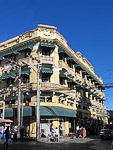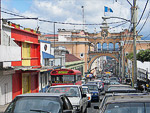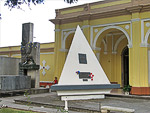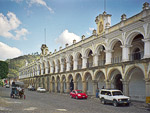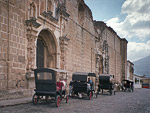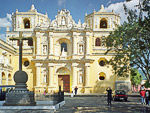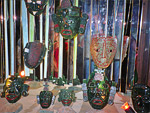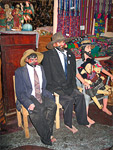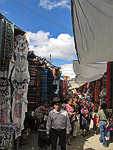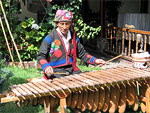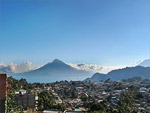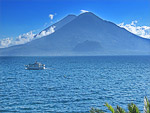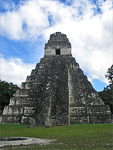«Banana curtain» of Guatemala
When my friend journalist Alexandre T. learned that I go to Guatemala, he said:— You won't regret. Beautiful, fantastic country. I used to open a TASS correspondent's office there, but not for a long time. They blew it...

— What do you mean blew it?
— They used a plastic bomb. Part of the mansion was demolished, iron gates were thrown away for several meters, the car was crumpled.
— When was it?
— In may 1988. At the times of president Cerezo. He tried to establish a dialogue between the guerilla groups and army that used paramilitary units for repressions. Cerezo did his best to break the «banana curtain» so that his policy of conciliation gained international support. He invited to the country «non-traditional» for Guatemala information agencies, such as «Prensa Latina» and TASS.
Somebody has given us a hostile reception. For example, the letters in which I was accused of secret connections with guerillas and espionage, used to be planted to me. Anonymous letters contained threats: «Get out of here, while the getting's good». I thought they were just threatening. But it turned out that ultras were moving fast in Guatemala. After the bomb we had to urgently pack our things: the TASS authorities insisted on it and president Cerezo himself advised us not to stay too long due to lack of «safety guarantees». So, I worked in a fantastic Guatemala only about six months. At the airport «La Aurora» I came across one Cuban – they also «asked him to leave»...
I recollected that talk while «travelling» through web-pages devoted to Guatemala on the eve of my departure. What an abundance of information, useful and not very much, visual and graphic, even from satellite! You can zoom in any part of the territory of the country to the «bird's eye view» and comfortably get acquainted with the most hard-to-reach places of Guatemala. Initial statistic data? You are welcome! Population of the country is more that 11 million, 60% of which are Indians, descendants of the Maya people. There are 33 volcanoes in the country, 3 of them being in active phase, but without frightening excesses – just emitting smoke and noise a little bit. Currency of the country is quetzal (after the name of an exotic bird that is the symbol of the country).
I would frequently come across the news about rage of crime and riots of youth criminal organisations called «maras». At the site of the US consulate in Guatemala there were given specific instances of attacks including on the buses with tourists. And it was not in some back of beyond, but on main motorways, sometimes under the nose of the police. Due to this reason it was recommended at the first demand to surrender to the Guatemalan «mobsters» everything they ask for: starting from photo-cameras to credit cards, because the attempts to resist «frequently led to negative consequences».
I tried not to think about those «consequences» while looking in the «world-wide-web» for information about hotels in the capital of Guatemala. Finally I have chosen «Royal Palace» hotel (four stars). The advertising text on the web-page of the hotel ran: «Elegance of the past, modernism of the present, tenderness in service».
Guate: first impressions
While talking to a taxi-driver (what could we do without them!) that was taking me from La Aurora airport to the hotel, I understood that its capital, the full name of which is Nueva Guatemala de la Asuncion, the residents shortened to Guate. The shortened variants of the names are also used for other cities: Chichicastenango – Chichi, Panajachel – Pana, etc. But tourists frequently call the capital in American way – Guatemala-city or Guatecity.
We were passing the city at dusk, and it seemed to me that the driver abused the speed, not slowing down at cross-roads, trying to pass the streets with poor illumination as soon as possible. I couldn't help asking him about «maras», whether they were as dangerous as the newspapers write about them. This question must have been put to the taxi-driver more than once, that is why, without hesitating he answered: «We do not conceal our drawbacks here in Guatemala. We honestly speak about crime. It is not less in other countries, but they keep silent about it. Do you think in Mexico, Honduras, Nicaragua or El Salvador the things are better?»
Despite our nodding acquaintance the driver was more than candid, and told me that many groups of «maras» were under the patronage of «corrupted military and policemen» who provide the bandits with weapons and, using our Russian term, were «roofing» them, getting some part of the loot. Such interaction – is one of the reasons for elusiveness and invulnerability of «maras», the struggle against which was proclaimed a priority by all recent governments of Guatemala.
I was amazed by pomposity of «Royal Palace». It preserved the atmosphere of early XX century hotels: palace entourage, luxurious gilded stucco work, finishing that imitated fumed oak, marble of staircases, carpets. In a spacious room the fan blades were noisily revolving under the ceiling. I saw something like this in screen versions of Graham Grin novels. With ceiling fans, definitely, it was more exotic than with plain air-conditioners.
The next day I learned that all the services in the hotel are paid ones (no free breakfasts!) and the only computer (of antediluvian times!) is available with the receptionist under the lock and key. The ideal advertised image of «Royal Palace» that was let into a «world-wide-web» was collapsing before my eyes.
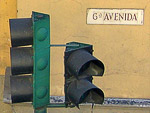
«Immersion into the elements of peoples life, I said to myself. At avenida La Reforma or Las Americas, where expensive hotels are located and privileged Guatemalans live, you won't see such diversity of characters, street scenes and situations. That's what it means to settle down knowingly!»
I could experience the uneven pulse of Guatemala in everything. Even in the restaurant of «Royal Palace» one could clearly hear its beating. In different corners of the spacious hall the Guatemalans, participants of various «current events» that were carried out in all free premises of the hotel, having pushed the plates together had a collective breakfast.
– Salud, camaradas! – I heard. A man by a rot-front gesture greeted a group of men and women in red shirts who made themselves comfortably at shifted together neighbouring tables. The waiter, having intercepted my curious look, bent down to me and confidentially whispered: «These are Communists. Former guerillas». The guerillas did not look dangerous. Judging by separate remarks that reached my ears, they gathered at convention having a particular reason: the government once again delayed payment of «demobilization» compensation. They discussed a plan of joined actions as to how to get the debt – without hue and cry, with faith in a rightness of their cause.
A little bit further the students of «intensive course» on the problem of «Legal protection of interests of Indians» were diligently gulping down their simple breakfasts. Many of the participants wore national clothes. Men in shirts with embroidery, with fabric waistbands instead of belts, woven trousers knee- or ankle-length. Women wore even more exotic costumes – bright embroidered blouses huipil and none the less brighter skirts corte, – actually pieces of fabric 3-5 meters long that were wound on hips and fastened by small belts made of cotton or wool. By this belt a native resident of Guatemala can unmistakably identify, which village its owner comes from. Till now at the streets of cities and especially in rural areas one can frequently see people in such clothes.
Further in the hall behind three shifted together in line tables, some women (basically of Indian appearance), many of whom clad in all black, were deliberating on something. On the nameplate towering above the coffee cups one could read «Conavigua» that meant National coordination center of widows of Guatemala (Coordinadora Nacional de Viudas de Guatemala). The centre was established in 1988 to organise the search of burial places, exhumation of victims of «anti-guerilla operations», providing help to the victim families and bringing the chastisers to court. In its activity the members of «Conavigua» faced shadowing, threats of death, attempts to prevent the next excavations of numerous nameless burial places. Somebody wants very much that the bloody tragedies of the past remained under the safe cover of the earth for ever, amnesia and impunity.
Among 100% chapines
I studied the Guatemalan capital with the help of Yuri S. with whom I got acquainted via internet. Just a few years ago he was a Muscovite and worked in one of the Moscow restaurant orchestras. Some of his friends invited him in a tourist trip to Central American countries. After two weeks a friend returned to Moscow, but S. remained in Guatemala. The country struck him so much by «exotics of Maya civilisation» that Yuri turned into, as he puts it himself, into an «enchanted stranger». And he did not betray his guitar – a good musician will not remain unemployed in Guate.

– Arguments about the origin of the word chapin, Yuri narrated to me, is a favorite intellectual occupation of the Guatemalans. There exist different versions. One of them is connected with a Mexican province Chiapas, that is considered by Guatemalans a «lost territory». Chiapas by birth, who settled down in Guatemalan cities and villages were called chiapines. These were businesslike, energetic, outstanding people, and it was from them that this interchangeability of meanings of the words «Guatemalan» and «chapin» derived. There is one more version that cannot be neglected. There was a time when at the end of the 15th – beginning of the 16th century when people used to wear shoes with pointed noses – chapines. They were very inconvenient in wear, but irresistibly attractive for men of fashion of that time. Residents of the Guatemalan «backwoods», inexperienced in fashion, talked over unpracticality of the townsmen: how can they wear these comic shoes in which they would stumble at every step, that men of fashion as usual keep on falling down at plain surface. So it came like that, the townsman is a chapin. With the time, the initial ironical shadow of the word has been forgotten. So the expression a «100-percent chapin» in a modern Guatemala, sounds proudly, without any implications.

— How can you characterise an «average» chapin? - I asked.
— The Guatemalans give «average chapin» a lot of merits. Here there are some of them: he is a toiler, a man with a kind heart, who is not afraid at a difficult time, rather inventive in a complicated situation, persistent in reaching the goal, makes jokes not to cry, tends towards dreaminess, in relations with mighty of this world allows himself some elements of conformism (as it were, diplomacy from the position of weakness). And the last: he will never at his own will trade his native tamal for the most appetising alien turkey

— If you believe my files of newspapers clips, many Guatemalans look for better life abroad.
— You are right. The economic situation in Guatemala is such that an average chapin has to look for happiness at a strange land. As often as not, he goes off in search of a living to the United States, where a million and a half Guatemalans live, half of which is illegally. The well being of one third of the families in Guatemala depend upon dollar transfers from the USA. As far as I remember, in 2005 three billion dollars came from there. In 2006 – three and a half. If one can earn heavily, no obstacles at the border are going to stop him. Some of them are not lucky. They are caught by the police, then surrendered to migration service and sent home. Expulsion for chapin – is a real tragedy, situation with employment in Guatemala is very strained...
Later in my files I found confirmation to these words about massive expulsions from the USA. In 2005, for example, about 10 thousand Guatemalans were subjected to such sanctions. In 2006 their number was doubled. According to estimation of International organisation on migration issues, in 2007 the record number of Guatemalans is going to be expelled – 25 thousand! By the way, this vulnerability of the Guatemalans on the US territory negatively affects the rating of popularity of president Oscar Berger and his government. Right centrist Berger maintains tight ties with the Bushes, and Jeb, present governor of the state of Florida, brother of the American president George junior, is considered to be a friend, frequently visits him. Average Guatemalans cannot understand, why, having so tight relations of the head of the state with the Bushes clan, he is unable to defend the interests of chapins who went to earn their living to the richest country of the world?
In July 2006, according to the polls made by «Prensa Libre» newspaper, the activity of Berger was negatively assessed by up to 74% of Guatemalans. 84% of those interviewed thought that in home and foreign economic policy the country is going in the «wrong way». The people obviously expect changes, and not only in economics.
Yuri demonstrated to me the places of interest of the capital: presidential palace, parliament, Cathedral, the building of Cultural complex named after writer Miguel Angel Asturias, city post-office, arch thoroughfare under which is one of the most photographed by the tourists «objects» of Guatemala-city. We also dropped to a few museums – of Indian clothes (Museo Ixchel de Traje Indigena), National museum of archeology and ethnology, and also the museum «Popol Vuh» named in such a way in memory of the epos of the Quiche Maya people, which tells about origin of the world, mankind, heroic deeds of Indian chiefs and heroes. This epos is one of the few remained prehistoric monuments of pre-Hispanic America, but unfortunately – in later copies. The original was irretrievably lost. A fanatic catholic priest cast it in fire.
We wondered around the souvenir market located near the presidential palace. The best seller was a tee-shirt with inscription «100-percent chapin». I could not resist and bought one, thinking that such an attire can help to «lay bridges» of friendship with Guatemalans.
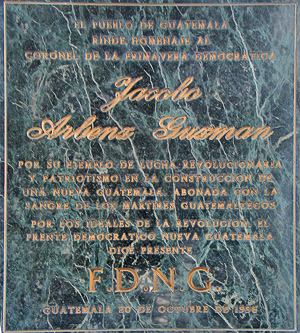
Arbenz was overthrown as a result of conspiracy arranged by the Central Intelligence Agency. Practically all the details of that large scale CIA operation that has become a classic sample of successful neutralisation of «unfriendly» to the US regime at present are known – almost all the archives, including those of the American intelligence, «started talking»...
«Red president» of Guatemala
If somebody thinks that reformatory epoch of president Jacobo Arbenz is the turned («rejected») page of history, he is very much mistaken. The United States have interrupted the process of transformations started by Arbenz by interfering in the internal affairs of Guatemala on the pretext of coming from it communist threat to Latin American and Caribbean countries. The Arbenz government denounced these insinuations declaring at international forums about its course directed to evolution way of development, strengthening of democracy, gradual social transformation of the society, increase in cultural-education level of Indian population. Implementation of the agrarian-land reform has harmonically blended into this strategy of actions.
Rage of Washington was caused by nationalisation of 90 thousand hectares of the best lands of «United Fruit Company» at the Pacific coast without respective, as thought by its owners, compensation. This «hostile action» of Arbenz was attributed to influence of communists. Moreover, intelligence services practically daily reported to president Eisenhower that Moscow was close to establishing the complete control over Guatemala by deputing there hundreds of «saboteurs and spies» and tons of weapons. The news about «hiding-places» with Soviet weapons at the Atlantic and Pacific coast of the country regularly appeared. As it was revealed many years later, the «hiding-places» were set up by operational officers of the CIA. There used to appear the most incredible publications such as that Arbenz government provided Guatemalan ports for Soviet submarines bases. It was at that period that the American propaganda started to call Guatemala the country behind the «banana curtain» by analogy with the «iron curtain».
CIA veteran Howard Hunt in his memoirs told the story how the legend of «communist penetration» to Guatemala was being created. In his agency within the framework of Western hemisphere department, a «semi-autonomous unit» was set up, composed of experienced agents with own financial funds, radio stations, group of «engaged» Guatemalan journalists – adversaries of Arbenz. This unit of «psychological warfare» was stationed in the marines barracks at Opa Locka (Florida). Subversive masters knew why Washington had taken up arms against the regime of Arbenz: the owners of banana company «United Fruit» had «complained» on it. Its lawyer - Thomas G. Corcoran was a genius of lobbying. With adroitness of an acrobat he used any reformist steps of president Arbenz to blame the «Marxist nature» of the regime, intimidated the Americans of the threat of spreading of «red instability» and «confiscation of private property» throughout the continent.
In Honduras the CIA advisors raised an invasion brigade headed by Castillo Armas. It crossed the border practically meeting no resistance from the Army of Guatemala. Powerful CIA radio station from Honduras jammed the government radio of Guatemala by broadcasting alarming reports about manifold superiority of the «patriotic liberation army» over the army of «Marxist-tyrant». Misinformation was effective: governmental and military circles were more and more tending to the need of capitulation.
Arbenz did not want a civil war. Besides he also knew about capitulation disposition in the army, unwillingness of the military to fight the detachments of Castillo Armas that were victoriously moving towards the capital. According to Hunt, the participants of the operation greatly enjoyed the work done: «For the first time since the civil war in Spain the communist regime was defeated». Castillo Armas has become the new president of Guatemala. However, he did not remain at power for a long time – he was assassinated by one of his bodyguards. In this Howard Hunt detected a «Soviet trail»: «Among the documents found at the bodyguard we revealed the proof that he was a regular listener of «Radio Moscow» in Spanish. According to another version the president was killed at the order of American-Cuban mafia which tried to set up a chain of casinos in Guatemala. Castillo Armas banned gambling business in the country and immediately paid for it.
The conspiracy arranged by American special services, Guatemalan oligarchy and the military clique against Arbenz resulted in cutting down of reforms and long-term bloody repressions. The country has slowed down in its development for many years and that was especially reflected upon extremely critical position of the Indian population. Thick «banana curtain» fell down on Guatemala, and not at the will of the «communist regime» but according to the strategy of Washington in restraining the «Kremlin expansion» in the Western hemisphere.
The «banana curtain» that separated Guatemala from the outer world, existed for decades of guerilla war, when not less than 200 thousand people fell victims to it. The US ruling circles were interested in concealing the truth about their interference in the home affairs of Guatemala, various ways of participation in repressions against the local population using the «technologies» mastered at «School of the Americas».
The United States till today fear revival of Jacobo Arbenz ideas, emergence of influential independent politician, capable for historic revenge, that is for carrying out radical structural reforms in the country. Twenty years passed since five presidents of Central American states signed a long-awaited treaty on conciliation in Guatemala «Esquipulas II» (on 7 August 1987). The period seemed to be quite long, it is the right time to yield abundant fruit on the fields and homes of national wellbeing and prosperity. But in reality the problems did not become scarce: Guatemala «slips» in solution of tasks of economic progress, industrial modernisation, social and political rearrangement, involvement of «humiliated and abused» Indian masses into an active public life. Understanding that the reason of lengthy national stagnation lies in the neo-liberal model of development imposed upon the country by American monopolies, is gaining strength. Such situation fully suits Washington and Guatemalan oligarchy, but not the Guatemalans themselves.
The processes of normalisation in the country have their own dynamics, so to say, of «slow haste». After 10 years of operation the UN Control Mission that was monitoring fulfilment of agreements on settling the inner conflict, left Guatemala. In his farewell interview the head of the mission Tom Koenigs however said, that Guatemala had to do a lot to eradicate poverty and racism. According to him, poverty of Guatemalans – is a reproach to neo-liberal projects of «improvement» of life in developing countries. Really, out of 11.2 million residents of Guatemala 3 million, that is every fourth, manages to «exist» for 1 US dollar a day. With permanently low wages one can never even dream of statistically «correct» food basket. It is especially difficult for people in rural areas where at least 60% of peasant-Indian population live on the brink of starvation.
In numerous studies of «nature of communism» the Western scientists permanently carry out the idea that «poverty brings forth communism». In the present Guatemala, that for decades has been under the imperial wing, there is extremely, too much poverty. If we consider that «communism disgracefully quit the historical arena» and was replaced by «populism» in Latin America, the probability of emergence in the same Guatemala of a national-populist leader is very high. These fears with all due absolutism are seen in declarations-conjuration of Guatemalan right-conservative politicians, which in general view are formulated approximately like this: «Chavez! Hands off Guatemala!»
Rigoberta Menchu – symbol of Indian revival
Remnants of racism in Guatemala, marginal position of Indians, their miserable living is practically in everything – access to health care, full education, to important administrative posts etc, are evident for any a little bit observant person. Involuntarily you start thinking that if president Arbenz managed to bring his reforms to the end, would the descendants of the proud nation Maya be in such a desperate condition as today?

Different people I spoke to, used to say that Menchu, being a president nominee from left and Indian organisations, made a right step, running for elections without real chances for victory. For all the years of existence of Guatemala this is the first Indian claim for power in the country. All the recent years Menchu was preparing for elections. Partially because of this reason she established the named after her fund that was controlling a chain of low-price medical-pharmaceutical service of those layers of population that is below the poverty level. So she has a permanent back-up, especially among the Indians. But that is insufficient so far.
«I dream of Guatemala for all, – Menchu says, – so that my son could not reproach me for discrimination on the basis of colour of the skin, language or social position. I would like to see all to be active participants of revival of this country».
The world conservative mass media carry out a tireless campaign on compromising this Indian activist. With this purpose they distort the facts of her autobiographic book «My Name is Rigoberta Menchu» published in 1983. The book was being created in close cooperation with Elisabeth Burgos-Debray (wife of a famous Marxist Regis Debray) and that is why it is permeated by revolutionary ideology, challenge to all ultra-reactionary forces in Guatemala.
In the town of Antigua and further along the tourist route
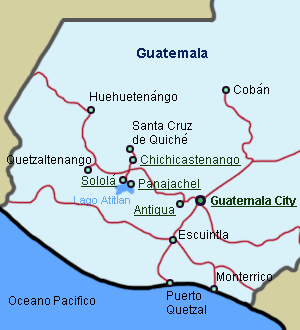
The town of Antigua is situated 50 kilometers away from the capital, in the valley, where roses bloom all year round (such a micro climate, eternal spring!). In the colonial epoch there was a governor «administration» (capitanes generales) there, which for more than 230 years ruled the Central America. At present the luxurious governor palace is occupied by clerks of much lower scale, whose names would hardly be entered into bronze tablets of history, unless it is some notorious drug or corruption scandal that are quite many in Guatemala.
Guide-books call the town of Antigua an «architectural pearl» of Latin America. «Staggered planning» of streets and avenidas, traditional Main square, dozens of church temples and monasteries, ancient paving stones, on which horse-dawn carriages are ceremoniously driving – all this enchants, conquers, creates an illusion of submersion in a colonial epoch. And along the perimeter of the city at distant approaches one could see blue silhouettes of classic cone-shaped volcanoes. The most spectacular and outwardly peaceful one is called Agua. It was because of its «fault» the first capital of Guatemala, located just a few kilometers away from Antigua, was perished. The underground «furnace» suddenly started to operate, but instead of lava the volcano splashed the streams of boiling water and mud that fell upon the city. Contemplation of that catastrophe traces in Ciudad Vieja - «Guatemalan Pompeii» is included into a «mandatory tourist menu».
In Antigua there are five to six foreigners per every local resident. This flooded by tourists town Guatemalans sometimes as a joke call «Gringotenango». Among its guests prevails the youth from Western countries, specially from the USA that comes to the town with pragmatic goal of studying Spanish. Here there are many such specialised schools and they are never empty. I did not manage, alas, to meet any Russian «students» in Antigua. Guatemala is too far away from habitual routes offered by our tourist firms to our native fidgets, keen on «changing places». For the Russians, in fact, Guatemala remains an exotic country behind the «banana curtain», although diplomatic relations were established in 1996.
Despite the outward patriarchal character, the town of Antigua is very well blended into the XXI century. Here, natural, historic and human potential for «promotion» of commercial-tourist attraction of the town and its suburbs is competently used. Hotels of different «starship», little restaurants and internet cafes are met at every step. Souvenir shops are packed with goods. Among them there are unique in quality articles, the price of which often «hike» to several thousand dollars. These are the copies of decorations and ritual masks made of jade, favorite decoration stone of the Maya rulers.
Among the souvenir «products» one is surprised by original «dolls» – sitting full-sized male figures. They can be mistaken for mannequins. Some of these figures even wear sun glasses. The seller patiently explains that these are by far not the mannequins, but Maximons, a cult creature, «pagan mediator» in the matter of fulfilment of wishes between the earthly petitioner and almighty, positively «oriented» weird forces. Souvenir Maximons, however, do not have this authority, so one has to go, where the sacred altars of that «mediator» is located (in Guatemala there are 3 or 4 such places), the predecessor of which was Mam, – in pre-Columbus times it occupied an honourable place in the Maya mythology.
Usually, when a Guatemalan wants the weird forces to help him to achieve success in business or gain somebody's love, increase in salary or root out the evil, he gives the priest a personal renumeration – the agreed sum of quetzals for performing the ritual and mystique actions. With Maximon it is much easier, he is more modest in his needs and is happy with, as a rule, a cigar, bottle of rum and lit candles. You only have to put the bottle of «Venado» or «Botran» rum in the open lips of the «pagan mediator», and the bottle content quickly disappears. The experienced people say that the almighty Maximons have glass or plastic «stomachs». For a visitor it does not matter, the most important – is realisation of wishes. In the bitter age of total competition, struggle for a well-paid job, privileges or patronage of some influential dignitary one should take any chances for success.
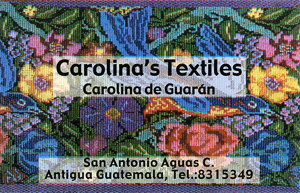
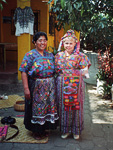
Chichicastenango – where our minivan started after Antigua is famous for its Indian market of «typically Guatemalan articles» – starting from textile goods in Maya tradition to wooden masks, whose most widespread «topic» are conquistadors with big mustaches. If you look more carefully to them, it will become clear that the Indian memory depicted the conquerors more with irony and mockery than with fear and reverence. Conquistadors as interpreted by the creators of masks are complacent, dumb, full of arrogance aliens, who boast of the looted goods and brute force, but totally deprived of any real human virtues.
The walk among variety of colours of Indian clothes and all kinds of handicrafts is accompanied by a melody of marimba. Marimba resembles a generally known xylophone, but made of noble sort of trees, according to strict rules of «national technology». Marimba is a mandatory musical accompaniment to Guatemalan fairs, festivals, holidays and celebrations, including the family ones.
The town of Panajachel is situated at the lake Atitlan shore, that is often called an «inner sea of the Maya empire». It is pleasant to stand on its shore. Transparent blue water, silhouettes of volcanoes, cloudless skies – all this assists to a special condition of spirit, contemplation and immersion into oneself. It is not by chance that this place a couple of decades ago was chosen by hippies from the USA, who set up their pacifist colony here. Who knows, it might be their silent protest and thoughts of love and peace (Make love not war) helped to establish a dialogue in Guatemala.
After the trip on the lake tourists are treated to a dinner, the best dish of which is called «Pancho Villa». In the menu it is marked as a «typical Guatemalan food» - meat, black beans, rice, fried bananas, cheese, tortillas and guacamole. Nobody could explain to me why that dish was called «Pancho Villa». Could a legendary Mexican guerilla make a raid to this area?
One-day trip along the National park Tikal has something in common with adventures of Indiana Jones, but in extremely «light» form. First – the flight from Guate to Santa Elena town, situated in Peten department, then - quick march on the winding road, along which from time to time there appear concrete fortifications and guard towers of abandoned military bases. These were the strongholds for fighting with the guerillas. When peace came to Guatemala local people demanded to shut down these bases, through torture cells of which passed and vanished into the thin air hundreds and thousands of people. That is why when in thick scientific treatises on Maya civilisation you come across the passages of unusual cruelty of that nation, you involuntary start thinking that our civilisation does not shine in humanity and Christian forgiveness to all.
However, for the pyramids of Tikal that is all in the past – neither chiefs, nor wars, nor struggle for survival, nothing, but the groups of sweating tourists and archaeologists who, with diligence of a mole, keep on excavating in the National park, the area of which is 576 square kilometers. The park territory now open for visiting, does not exceed 16 square kilometers, where under ground there are still at least 3 thousand structures. Tikal stirs emotions that very much alike to those experienced by Indiana Jones during his quests for ancient rarities. Even the sightseer-nuns surrendered to a powerful energetics of the pyramids and fearlessly sank into the «world of adventures» - wandered along the tunnels with torches, climbed the stone tops on fragile staircases, squeezed through narrow paths in selva under the accompaniment of cries of howler monkeys. They resembled me mischievous nuns from the films of Lois de Funes...
«Banana curtain» will go for souvenirs
Many of the elderly supporters of president Arbenz have never decided to return back to Guatemala. After signing «Peaceful agreements» they used to buy once, twice and trice «return air tickets», visit their friends and relatives, looked into the environment trying to understand whether these democratic winds of renovation and attracting freedom have come for a long time. Among them was a poet Otto-Raul Gonzalez, author of the poetry book «Mutilated Moon» («Luna mutilada») (1991), in which he bitterly called Guatemala a «country of shame, where corruption and cynicism rule, where nobleness has been thrown to prison, patriotism has been buried in the ground and honesty is living in the exile».
Poet Gonzalez has recently died in Mexico (26.06.07) having never taken the last real step of reconciliation. He did not return because he could not believe that changes in the country were serious and for a long time, and that sweet word freedom – is pronounced sincerely. With all outward changes, the oligarchy and land owners are still controlling the levers of power, and reaction military have just slightly yielded, all key power posts are still in their hands. Drug business emissaries still play the master with impunity, actively investing means into election campaign of alcaldes so that to secure «commercial territories» for themselves. American influence still prevails, including in the information sphere. However, «scary bugabooes» were adjusted according to the present day requirements of the empire. At the epoch of the «cold war» they used to scare by «hand of Moscow», nowadays – by threat of expansion of «Chavez dictatorship».
Guatemala is waiting for the changes. And the necessary prerequisites for revival of the country exist: through decisive overcoming of the civil war consequences and use of inspiring example of those Latin American countries, where the so called «populist regimes» are at power. It was them who declared their goal to build a socially just society, provided the Indian population of their countries with real constitutional rights.
«Banana curtain» of Guatemala lives out its days. When it is resolutely and finally torn down, some enterprising chapin will be able to earn good money by selling the imaginary pieces of that curtain to tourists as a souvenir.
* * *
The complete article is published in the magazine «Latin America» ("Latinskaya America") №9, year 2007.

